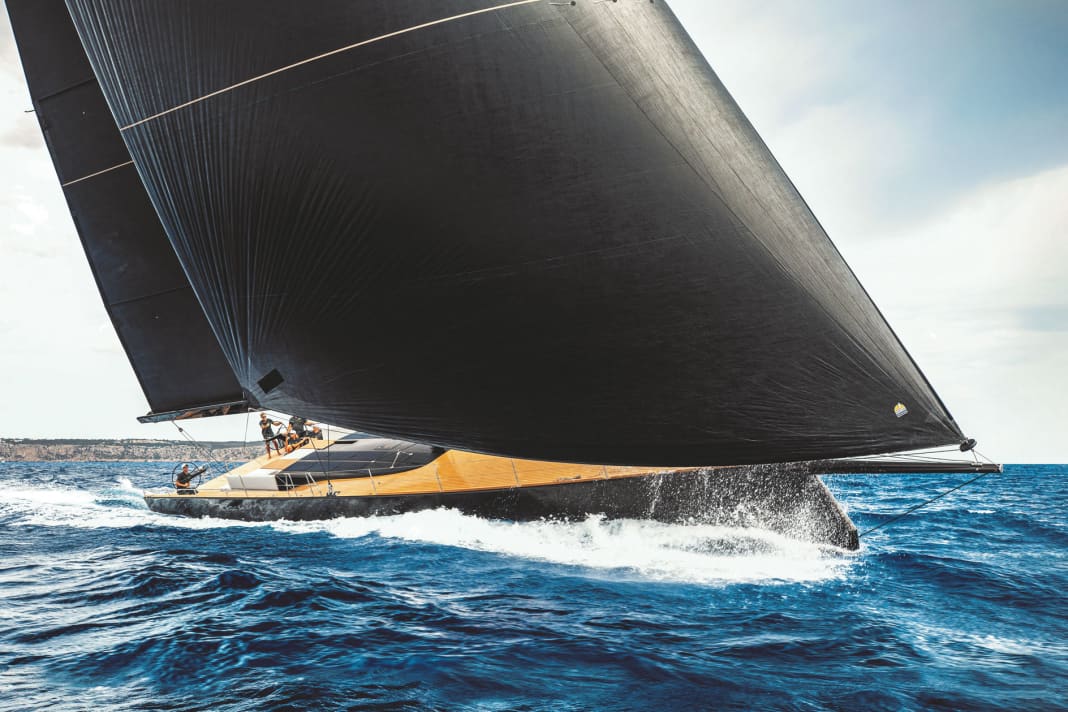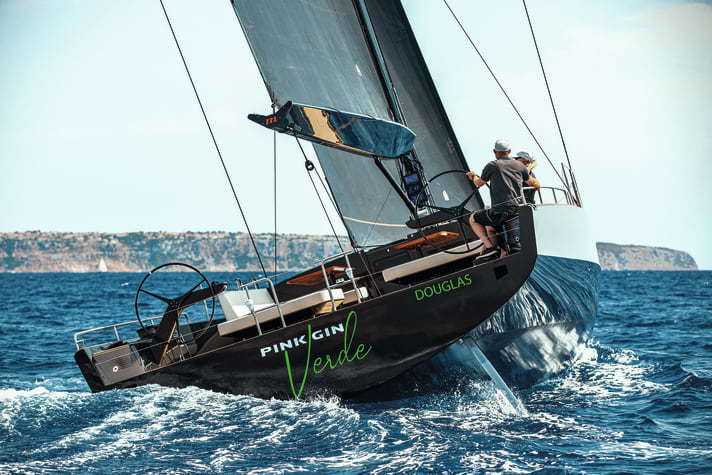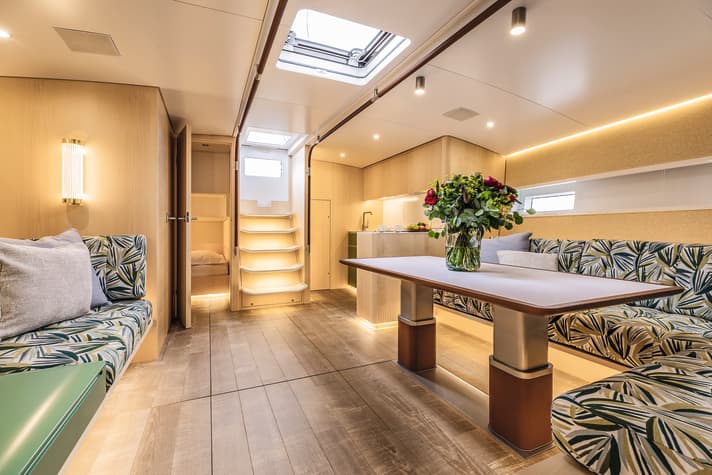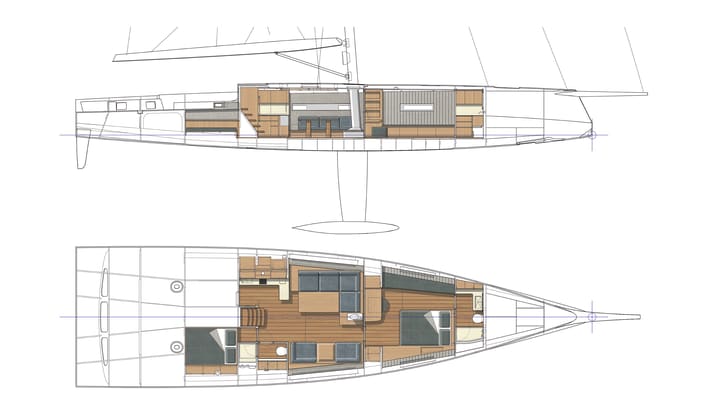









Article from 31.1.2023:
A racy 22-metre yacht for a small crew, powered only by wind and electricity: with its café racer Baltic 68, the Finnish shipyard takes sustainability at its word. We were on board in Porto Cervo
When you think of romantic hours for two on board, the idea of a gondola trip through Venice's canals comes to mind. A considerable amount of imagination would be required if the dream of togetherness were to be transferred to a 20.73 metre maxi sailing yacht. But with the help of the Baltic shipyard, known for its solid and innovative boatbuilding skills, the fulfilment of this dream has just come a good deal closer.
The Finns presented the Baltic 68 Café Racer to the public at the Maxi Yacht Rolex Cup regattas off Porto Cervo, Sardinia, last autumn. With its elegant carbon black hull, night-shade dark Doyle sails and a light-coloured teak deck look, the maxi daysailer christened "Pink Gin Verde" cuts a fine figure even in the illustrious circle of superyachts.
"Café racers" are actually rattling motorbikes
The term "café racer" is reminiscent of a subculture in England in the early 1960s, when highly customised motorbikes reduced to the essential technical elements enjoyed cult status in the semi-indie rocker scene. The fun started in London's legendary Ace Cafe and consisted of racing the distance from the pub to the next roundabout and back on the rattlers before a rock 'n' roll single selected in the jukebox had even been played. The term "record race" was coined, after the English word for record.
Baltic main shareholder Hans Georg Näder wants to rock the maxi circus today with the Café Racer. His supersailers with the name "Pink Gin" have long been legendary in the scene. There are good green reasons why he added the surname "Verde" to his new acquisition. Nothing stinks or rattles on the yacht.
The idea for the minimalist, tidy maxi-sized daysailer is more than 20 years old and comes from Italy. Stumble-free decks, sail control at the touch of a button, spacious interior design and the use of lightweight carbon materials signalled a quantum leap in yachting. However, the dream of a cruise for two ultimately remained unrealistic. Instead, a regular crew consisting of skipper, deckhand and stewardess and a constantly humming generator that supplies the power to operate the sails and supply the air conditioning with electricity was realistic.
Back to the roots with the Baltic 68
The thoughtful Finns with their high quality standards have been able to gain experience with such modern formats themselves over the last two decades. Their 33-metre cruiser/racer "WinWin", for example, built in 2014, made an exclamation mark on the superyacht scene and also impresses on regatta courses, albeit with the help of two dozen muscular co-sailors on board. With the Baltic 68, the shipyard has returned to the roots of the maxi daysailer: a contemporary design at the cutting edge of environmental technology, pitch black, but with a green heart. The shipyard entrusted the design of the Baltic 68 to designer Javier Jaudenes from Palma de Mallorca. Jaudenes may not yet be well known, but as the designer of "WinWin" he has long since recommended himself for higher tasks.
"Pink Gin Verde" has a slightly negative deck leap, a clearly negative stem and a wide, flat stern with attached twin rudders, which make steering easier on rough courses. A four metre deep, 8.2 tonne keel with bomb hangs at the very bottom. All state of the art, of course. A flat deckhouse is located amidships, behind which are two U-shaped sofas with tables without a permanent roof. The open-air salons are typical of daysailers. If the sun is too hot, a bimini is opened. A sprayhood over the companionway and a protective cockpit to keep out the water are consistently dispensed with. After all, you want to explore the beautiful anchor bays in the Mediterranean and the sunset at Capri, not the Finnish archipelago in the Arctic Circle.

Clean deck without tripping hazards
Nothing on the deck gets in the way. Aft are the two steering wheels with navigation screens and the button panel for the automatic sailing system, next to consoles for two electric winches each, as well as a slot through which the four spiderweb-fine sections of the mainsheet are fed. On the foredeck you can see two flush-fitting deck hatches - no tripwires anywhere, just two holes in the deckhouse through which the jib sheets are passed. There are also no steps or landings. The low-lying aft deck is connected to the higher foredeck via a gently sloping side deck, suitable for wheelchairs.
But let's move on to the subject of two-handed sailing and how the technology helps. The Baltic 68 carries a Swedish Marstrom rig with shrouds positioned far out on the hull and spreaders swept strongly aft. This arrangement means that neither a backstay nor running backstays are required. This means that nothing hangs loose at the stern. This rigging even makes a streamlined mainsail with a flared fathead top possible. The mainsail is dropped into the shell of the Park Avenue main boom for recovery. The slightly overlapping furling jib provides power on cross courses, and if you want to switch on the turbo on rough courses, you can furl and unfurl the large Code Zero headsail on the permanently installed, protruding bowsprit at the touch of a button. With this sail, the cut of which was developed in collaboration with the sailmakers at Doyle, particularly with regard to the special requirements of furling, the ship promises real racer qualities at just under 23 tonnes.
Sailing for just two thanks to push-button automation
But what about togetherness? In fact, it would probably be possible for an experienced couple to bring the yacht back into harbour under sail in a moderate breeze. The ship is intelligently designed for this and, thanks to its push-button automation, is not a feat of strength. Technical failures, on the other hand, are not allowed. But if not the legendary Baltic quality, who else should you trust? With friends on board and a professional boatman at your side, who is essential for the maintenance of the boat anyway, the Café Racer is undoubtedly a great pleasure.
The ease of use and spaciousness on deck continues below deck. There are only two rooms here, each extending across the full width of the yacht. The generously proportioned owner's cabin with en suite bathroom is located forward. Amidships is a spacious saloon with a kitchenette and a separate day toilet. To starboard is a guest cabin with a double bed, which is somewhat spartan as it is located in the shallow aft section and therefore cannot offer any headroom. The spaces below deck can of course be customised, with options from various designers already worked out. For the first Baltic 68, the interior designers from Design Unlimited primarily chose light oak veneer and colourful leather as well as fabrics with floral patterns. The owner wanted a coastal landscape with palm trees for the front wall of the saloon and the wall of his private cabin. Chacun à son goût. The pretty "Pink Gin Verde" is, as described, a clear enrichment of the maxi scene. However, the yacht is coming onto the market at a time when topics such as the climate crisis and sustainability are constantly being discussed.

Hull, deck, stringers: as much natural fibre as possible
The Baltic 68 scores particularly well in this area. Although sailing is considered to be extremely environmentally friendly thanks to its wind-powered propulsion, there is still a lot of room for improvement in the construction of yachts and their auxiliary drives. The use of ultra-light carbon fibres for the hull, deck and rigging is a prerequisite for the construction of high-performance yachts, and the production of carbon structures is associated with a high consumption of fossil energy. There are also still problems with the disposal of carbon fibre fabrics.
Baltic therefore uses a composite fibre for the hull, half of which consists of carbon and half of ampliTex fibres from the Swiss manufacturer Bcomp. The ampliTex fibres are a purely natural material, as they are made from natural flax. The highly stressed parts of the fuselage are manufactured using the proven high-quality carbon corecell sandwich construction method. Balsa wood is used as the core material for the transverse and longitudinal stringers. The less stress-relevant parts of the equipment have a particularly insulating polyethylene foam core made from recycled plastic material.
The natural material cork, grown on sustainably cultivated cork oak plantations in Portugal, replaces the usual traditional teak decking. The material does not harm any tropical forests, it is virtually indistinguishable from teak both visually and to the touch, it is bonded with a natural glue, is non-slip and does not rot.
The Baltic 68 is fully electrified
The Baltic shipyard has taken the most consistent step towards environmentally friendly technology with its propulsion system. The Baltic 68 is fully electrified: CO2 footprint: zero. The battery banks in the aft "engine room" supply the energy for two lightweight 15-kilowatt electric motors, which bring the ship to life when sufficiently charged (with shore power). They supply power for the Saildrive tide shifter and the bow thruster for manoeuvring in the harbour. The power lasts for 13 hours of sailing at a speed of five knots. Electricity also powers the winches on deck, the halyards and sheets, i.e. the entire on-board electrical system on and below deck. In sunny waters such as the Mediterranean, air conditioning is a prerequisite. Air conditioning is known to consume the most energy on board after the ship's propulsion system. According to the shipyard engineers, the four solar panels installed on the deckhouse are sufficient to operate the air conditioning system continuously in eco mode.
Summary: "Pink Gin Verde" is a beautiful boat with wonderfully balanced lines and a powerful rig. The workmanship matches the quality of the best Finnish boatbuilding. The yacht's ease of operation at the touch of a button has reached a new standard. A yacht of this size travelling without a CO2 footprint is probably unique on the market. It couldn't be greener. "Pink Gin Verde" has long since proven that it can be much more than a daysailer. During the crossing from Palma de Mallorca to Porto Cervo in Sardinia in the late summer of 2021, the yacht had to battle a strong easterly wind for two days and two nights. Uncomfortable, but no problem. Crew: two men
Technical data Baltic 68 "Pink Gin Verde"
- Length over everything: 20,73 m
- length (LWL): 20,73 m
- Width: 5,63 m
- Depth:4,00 m
- Displacement (empty): 22,8 t
- Material: Carbon, flax, balsa sandwich
- Deck: Cork
- Mast: Marstrom
- Sail: Doyle
- Sail area (on the wind):271 square metres
- Sail area (outhaul): 600 square metres
- Winches: Rake
- E-motors:2x Oceanvolt
- Engine power: 2x 15 kW, 48 V
- Batteries: 73.3 kW/h
- Electronics: B&G
- Construction: Javier Jaudenes
- Exterior design: Javier Jaudenes
- Interior design:Jens Paulus
- Interior styling:Design Unlimited
- Shipyard: Baltic Yachts, 2021


